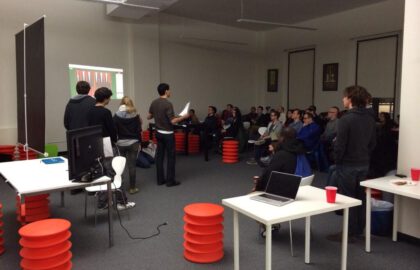Flatiron School Blog

Flatiron School
Project Recap: Kickammender
Like so many of our alums, Michael and Joe both applied to Flatiron School at points in their lives when they weren’t sure what was next: Joe was an economics major turned Marine, and Michael was shirking questions about applying to PhD programs. Now full-time developers, they used their time at Flatiron to level up […]

Flatiron School
Um, so we have these chairs…
… and Ruby 005 student Ben Serviss has cleverly used them as an analogy for learning to program. Who knew! Here’s his post, reblogged from here. The first time I walked into The Flatiron School, I thought to myself: “What are these crazy orange things?” I had come to one of the weekly NYC on Rails meetups […]

Flatiron School
Thank you, NYC
We are thrilled that The New York Times chatted with recent alum Jahmil Eady about her experience with the NYC Web Development Fellowship. The program is incredibly special to us, and it’s awesome to comb through tweets to see Jahmil’s story excite and inspire people—mostly because of how deeply it excites and inspires us. The […]

Flatiron School
Seeds
The following is a guest post by John Richardson and originally appeared on his blog. John is currently in the Ruby-003 class at The Flatiron School. You can follow him on Twitter here. Background: ADK 46-R The ADK 46ers are a set of 46 mountains in upstate NY higher than 4000 feet. If you climb all of these […]

Flatiron School
Hide Your Keys, Hide Your Tokens … Unless Deploying to Heroku
The following is a guest post by Greg Eng and originally appeared on his blog. Greg is currently in the Ruby-003 class at The Flatiron School. You can follow him on Twitter here. In that case, you have to do a little more than just hide them. Typically, an API will require a key or authentication token before […]

Flatiron School
Database Column Type – Array
The following is a guest post by David Bella and originally appeared on his blog. David is currently in the Ruby-003 class at The Flatiron School. You can follow him on Twitter here. Okay, So More Like “List” Relational databases are a great way to store, well, related data, in a base. Often times, we have to store […]

Flatiron School
Flatiron School Day Twenty Four – Include or Extend for a Module?
There are two ways to add a module to a class, include and extend.
Browse by Category
- All Categories
- Admissions
- Alumni Stories
- Announcements
- Artificial Intelligence
- Career Advice
- Cybersecurity Engineering
- Data Science
- Denver Campus
- Diversity In Tech
- Enterprise
- Flatiron School
- How To
- NYC Campus
- Online Campus
- Partnerships
- Software Engineering
- Staff / Coach Features
- Tech Trends
- UX / UI Product Design
- Women In Tech
